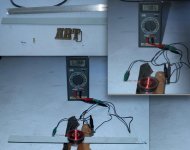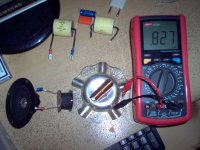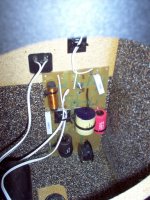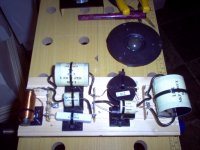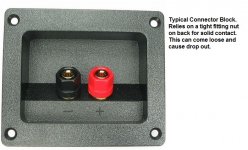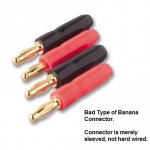Hi
There is a good info at greeboys' about the relative position of inductors. Although, nothing is said about metallic parts near around. I think about die cast aluminium dishes of woofers, or iron screws/nuts. What could happen to inductance when such materials are in the magnetic field?
Thank you
There is a good info at greeboys' about the relative position of inductors. Although, nothing is said about metallic parts near around. I think about die cast aluminium dishes of woofers, or iron screws/nuts. What could happen to inductance when such materials are in the magnetic field?
Thank you
nothing is said about metallic parts near around.
Keep inductors away from magnetic materials like steel. Other metals are ok,
unless the inductor is moving, which hopefully it won't.
As is implied in the position chart, proximity is important, the inverse square law can render the orientation (or metal parts) moot after doubling the distance.Hi
There is a good info at greeboys' about the relative position of inductors. Although, nothing is said about metallic parts near around. I think about die cast aluminium dishes of woofers, or iron screws/nuts. What could happen to inductance when such materials are in the magnetic field?
Thank you
Mounting an inductor near aluminum (such as a heat sink or speaker spoke) does increase inductance slightly, as do screws of any metal, though steel does affect inductance more than non ferrous metals.
As is implied in the position chart, proximity is important, the inverse square law can render the orientation (or metal parts) moot after doubling the distance.
Mounting an inductor near aluminum (such as a heat sink or speaker spoke) does increase inductance slightly, as do screws of any metal, though steel does affect inductance more than non ferrous metals.
Nope, near ferrous/steel increases; near aluminum or brass, decreases inductance.
You can virtually short out a coil with aluminum stacked on it.
Later,
Wolf
Wolf,Nope, near ferrous/steel increases; near aluminum or brass, decreases inductance.
You can virtually short out a coil with aluminum stacked on it.
Later,
Wolf
Thanks for the correction, my memory was wrong, been a long time since I added an aluminum heat sink to a resistor and found it reduced (not increased) the nearby coil's inductance.
Tested a nominal 2 MH coil under a variety of conditions to measure some typical effects:
The air core coil & former weigh 180 grams and read 1.95 MH.
With a .25 gram brass screw in the mounting hole, the coil read 1.94 MH.
With a .25 gram steel screw in the mounting hole, the coil read 1.99 MH.
On top a 100 gram brass belt buckle, the coil read 1.87 MH.
On top a 60 gram 40 cm aluminum angle, the coil also read 1.87 MH.
On top a 180 gram 40 cm steel strip, the coil read 2.22 MH.
Art
Attachments
Have a look on the original >>>> Placement of coils in crossover networks
Furthermore some additional Information.
Furthermore some additional Information.
Attachments
If the coils are air-cores and the distance between the perimeters of their coils is used as a reference instead of the distance between the coils' centers (as shown in the linked documents), you can locate adjacent coils 2 inches apart with both coils laid down flat, and mutual inductance and voltage cross-talk both become non-issues. It also doesn't matter if both coils are similar in inductance and size or very dissimilar. If space is limited, however, proper orientation is necessary.
Paul
Paul
One of the moderators here, Cal, I think, said to place coils so you can't see another looking down the axis. Seemed sensible to me. 🙂
I found the big interactions were coils with each other and ground planes like on circuit boards.
A 1mH coil is just 0.827mH on a ground plane, here a silver ashtray, which makes sense because it's a solid angle of about 20% if you follow. I found the tweeter coil audibly picked up the bass coil's 1kHz test tone from the multimeter if badly aligned. But nothing from a shunted capacitor across the tweeter.
Converted me away from PCB's, in favour of point to point on wood TBH. I also went off banana plugs unless hard soldered as much as possible.
I found the big interactions were coils with each other and ground planes like on circuit boards.
A 1mH coil is just 0.827mH on a ground plane, here a silver ashtray, which makes sense because it's a solid angle of about 20% if you follow. I found the tweeter coil audibly picked up the bass coil's 1kHz test tone from the multimeter if badly aligned. But nothing from a shunted capacitor across the tweeter.
Converted me away from PCB's, in favour of point to point on wood TBH. I also went off banana plugs unless hard soldered as much as possible.
Attachments
Last edited:
I agree that crosstalk from bass coil to tweeter coil can be a more audible concern than minor shifts in coil inductance....I found the tweeter coil audibly picked up the bass coil's 1kHz test tone from the multimeter if badly aligned. But nothing from a shunted capacitor across the tweeter...
Attached document has some discussion and measurements on coil crosstalk.
I usually use a pair of headphones connected to one coil and test signal to the other to optimize inductor placement/orientation for minimum cross talk.
Some more details here:
The "Elsinore Project" Thread -post#1139
The "Elsinore Project" Thread -post#1151
Attachments
- Status
- Not open for further replies.
- Home
- Loudspeakers
- Multi-Way
- Inductors placement
